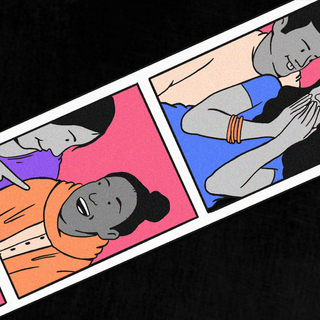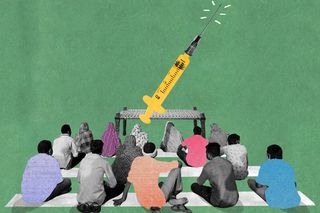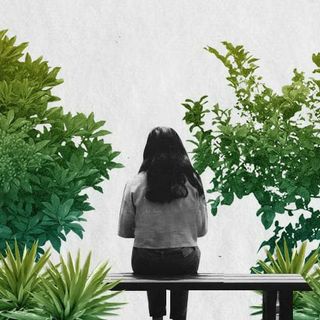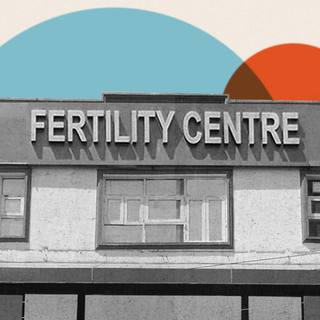
In Tribal Communities, Public Health Officials Are Using Traditions to Dispel Vaccine Hesitancy
Age-old concepts of “khatla baithak” helped public health officials address social media-fueled misinformation.

In Madhya Pradesh’s Jhabua district, where almost nine lakh tribal people live, a group of people sat in the searing heat of June as a baithak (meeting) was called into session. The topic in discussion? The Covid19 vaccine.
Vajah watched this group from a distance. As she faintly heard the words “tika” and “bimari” — Hindi for vaccine and illness respectively — one question plagued the 62-year-old: Does the vaccine cause the illness, or treat it?
So far, she had seen people — community health officers (CHO), Accredited Social Health Activists (ASHAs), Auxiliary Nurse Midwives (ANMs) among others — talking endlessly of the benefit of a Covid19 vaccine. But this vaccine’s timing seemed ominous as it coincided with a rise in deaths and cases. “People said ‘we will die, we will die’ — so we didn’t want to get the vaccination,” she says in Bhili, recalling the prevailing sentiment in the storm of the second wave.
Now, six months later, she stands in the same field, fully vaccinated with both doses. What changed her mind? “They came to us, they understood us.”
***
Skepticism and misinformation around vaccines have existed as long as vaccines themselves; an uneasy relationship playing out in circles. Especially across India’s tribal pockets, lakhs of people scattered around the country have long harbored a distrust of government policies.
Vaccine hesitancy in these regions resembles that in other rural or even urban areas, but historic oppression and lack of direct access to public health information amplify the hesitance. Diseases like Covid19 can be particularly daunting in tribal communities, as people live in close groups and travel regularly for work. Coupled with a lack of proper sanitation, nutrition deficiencies, and illiteracy, this group is left more vulnerable.
Related on The Swaddle:
Tell Me More: Talking Community Medicine and Vaccine Hesitancy in India With Dr. Aqsa Shaikh
By March 2021, myths about infertility and deaths related to the vaccine pervaded many tribal communities; some through WhatsApp and YouTube, others through word of mouth. In some tribal areas, villagers were running away from health officials; some women escaping under the pretext of going to fetch water while other climbed trees. In other areas, tribals told healthcare workers that they trusted the village deity to protect them. In the Nilgiris, a video claiming that anyone who got vaccinated would die in the next two years became notorious; officials called it a “major impediment.”
One misconception in the early days of vaccines in Jhabua was that only “sick” people need the vaccine. For locals who weren’t exhibiting symptoms, the vaccines seemed pointless. Dr. Rahul Ganava, the District Immunization Officer of Jhabua, says that the vaccination drive overlapping with rising cases strengthened the link between Covid19 vaccines and death. When the immunization drive started in Jhabua in March, less than 10 people came to receive it and most vials went to waste. “People struggled to understand why they needed the vaccination,” Dr. Ganava says. As of April 2021, only 20% of people were vaccinated in the area.
An ideological and physical distance separates these communities from health care. “Populations are dispersed, the terrain and communications are difficult to negotiate, making access challenging,” former health secretary K. Sujatha Rao told IndiaSpend, adding that “the public health system presence is typically weak with no doctors.” In most cases, the inoculation percentage among the Scheduled Tribes nationally is lower than the state average; experts attribute this trend to misconception around the vaccines and lack of accessibility.
The negotiation then has to occur on two fronts: one, to explain how immunization works against disease; and two, to inspire trust in a public health system that has largely excluded them.
The answer, in Jhabua, built on the age-old tradition of khatla baithaks. As the name suggests, villagers for decades have sat on wooden beds (khatla) to informally meet (baithak). The platform to resolve disputes also became a platform to disseminate information for health officials, where ASHAs, ANMs, CHOs would talk about implementing public health policies. But by May, when it was clear the vaccine was a tough sell, the baithaks were repurposed for community interaction. “It was decided to keep [the baithaks] at the village level,” says Urmila, a CHO in Jhabua, “where there was interaction, where people could voice their concerns.” The baithak was opened for local villagers to question and, more importantly, cross-question the vaccine. The model embraced a tone of empathy and transparency.
By June 24, the district set a record by administering 10,000 vaccines in one day; in stark contrast to the 1,800 doses per day in May. Today, the Jhabua population has a vaccine coverage rate of 98%.
Similar community gatherings in other regions, which prioritize direct one-on-one communication, also rendered results. Two-way communication that addressed misconceptions made people open to the idea of getting inoculated, NGOs India COVID SOS and Exemplars note. Research also shows that when it comes to disseminating unpopular beliefs like public health messaging, community leaders, “the people in the edges of the network,” have the greatest influence across the entire community more than outside workers. In a Maharashtra village, when an elderly lady, affectionately called Kaki, volunteered to get the vaccine, it helped turn the tide of acceptance.
Incorporating trust and respect for local culture then becomes imperative. Rupal Nait, a CHO in Ojha, a village near Jhabua, says the vaccination centers were decorated with familiar paraphernalia. “We asked the sarpanch (village head) to cut a ribbon there, so people feel that the elders of the village are being respected.” It definitely left an impact on Vajah: “When everyone else in the village started getting the vaccination, looking at them, we also got the vaccination.”
Officials also went from house to house, distributing peele chawal (raw rice coated with turmeric)as an invitation to get vaccinated, Ganava recalls. “This is understood as a ‘shagun’ (gift).” It signifies inviting people to an event respectfully. “If the household accepts it, it is believed the household will participate in the activity.” The activity here being getting vaccinated. By June, one could see young girls distributing peele chawal with songs on their lips. “Vaccine lagwana hain corona ko harana hain” (“To beat Corona, we need to get vaccinated”) became the sound of the ritual.
Rupal notes how “the elderly felt they were inviting us and respecting us, so that is how the ambiance changed.” After news of vaccination spread, locals in a nearby village Parnali also enthusiastically volunteered when health care workers reached there for health checkups.
Even with the second dose, when people exhibited side effects of fever, it was important to constantly be in touch. Prem Lata explains the checking-in process: people were monitored over a period of 1-2 days, given medicines for fever. The ASHA then went to their house in the morning; sometimes if they ran into a family member in the village, they would make it a point to ask about people’s health. “People remember these gestures and it helps build their confidence in returning for the second dose,” Urmila notes. An August report also showed the door-to-door drives conducted by ANMs helped reduce vaccine hesitancy in tribal belts of Rajasthan.
“When confidence and trust were established, that is when people looked on vaccinations favorably.”
Related on The Swaddle:
No Evidence of Covid19 Vaccination Causing Infertility in People, Govt. Clarifies
***
In the Nilgiris district, nestled between the Western Ghats, when a 100% first-dose coverage was announced on June 30th — the first to do so in the entire nation — it inspired awe and interest. Once the state government allowed vaccination centers to emerge near tiny hamlets, the idea was to tailor outreach campaigns to people’s identities, interests, and realities. One of the awareness campaign’s punch lines was “Vandhu vaccination podu, super starra thirumbi po” (Come, get vaccinated, return a superstar).
Language became central to breaking the ideological barrier. Several NGOs like Nilgiris Adivasi Welfare Association, Nilgiris Wayanad Tribal Welfare Society, and Adivasi Munetra Sangam deliberately translated all Covid advisory into Tamil, Malayalam, Irula, Kurumba, along with other local languages. Moreover, statements from vaccinated village leaders were also crafted in the native dialect; these testimonies were contextualized for immediacy.
“If you speak in the language of the local people, they will accept something more easily,” Dr. Ganava notes. The idea that language encourages familiarity and makes people more open to public health messaging has been widely studied. Around Maharashtra’s Melghat forest, home to thousands of Adivasis, doctors used the native Korku language to relay messages and urged them not to listen to Covid19 rumors. There is also a series of YouTube videos in Korku. For them, it is “not only the language, but the speaker too is one of their own, and that is why the video series helped allay long-standing mistrust of public health systems among tribals in remote areas,” tehsildar Maya Mane told IndiaSpend.
The other plank was to look at artforms and tribal artists. Tribal artists in Jhabua and Nilgiris starred in short movies aimed at building vaccination awareness. In Karnataka’s Chamarajanagar, storytelling, song, dance, and drama conveyed messages about Covid19 and the vaccines. At other locations, vaccination drives were improvised to include food and local music, Nait says. The familiarity of songs, movies, or theatre in local languages enacted by faces they recognize tethered on to people’s consciousness.
When health workers sing a song in Korku, for instance, the idea is “these people are a part of our community, they understand tribal traditions and culture,” Dr. Ganava says. Framed in the language close to them, the vaccination story in Jhabua and some other tribal regions changed. This counter-narrative may offer a roadmap for disease prevention — online and offline.
***
Dr. Ganava notes while the current efforts helped eke out a victory, the “bigger picture” is still in the making. The conversation about robust and responsive healthcare, one that takes into account economic dependency, must not lose momentum.
“All of these things the tribal people will listen to when their stomach is full,” Dr. Ganawa pointed out. He recalls the saying: “Bhuke pet bhajan bhi nahi sune jaate.” It roughly translates as “No one’s faith will remain if they are deprived of a necessity like food.”
“The people are not treated well when they visit the government facility either during pregnancy or when extremely sick,” a local in Coimbatore told The News Minute. “Such instances remain etched in their minds, firming their reluctance and distrust of the healthcare system.”
At present, a new phase of India’s vaccination efforts is playing out. A lot of tribal pockets are still waiting for a second dose, even as the central government announced efforts to launch booster shots. While India announced 1 billion vaccine doses in November, the data shows that tribal areas still lag behind. With the Omicron Covid19 variant further spelling uncertainty, the need to achieve egalitarianism in vaccination coverage is felt more acutely.
The vaccination story mustn’t focus only on Vajah and thousands of others, who remain outside the ambit of healthcare policy. The story here — one of novel practices and learning — must be preserved to address systemic issues behind hesitancy at a state level.
Otherwise, misinformation is doomed to be a top that doesn’t stop spinning.
Saumya Kalia is an Associate Editor at The Swaddle. Her journalism and writing explore issues of social justice, digital sub-cultures, media ecosystem, literature, and memory as they cut across socio-cultural periods. You can reach her at @Saumya_Kalia.
Related


Living Near Green Spaces May Reduce PMS Symptoms, Research Shows
